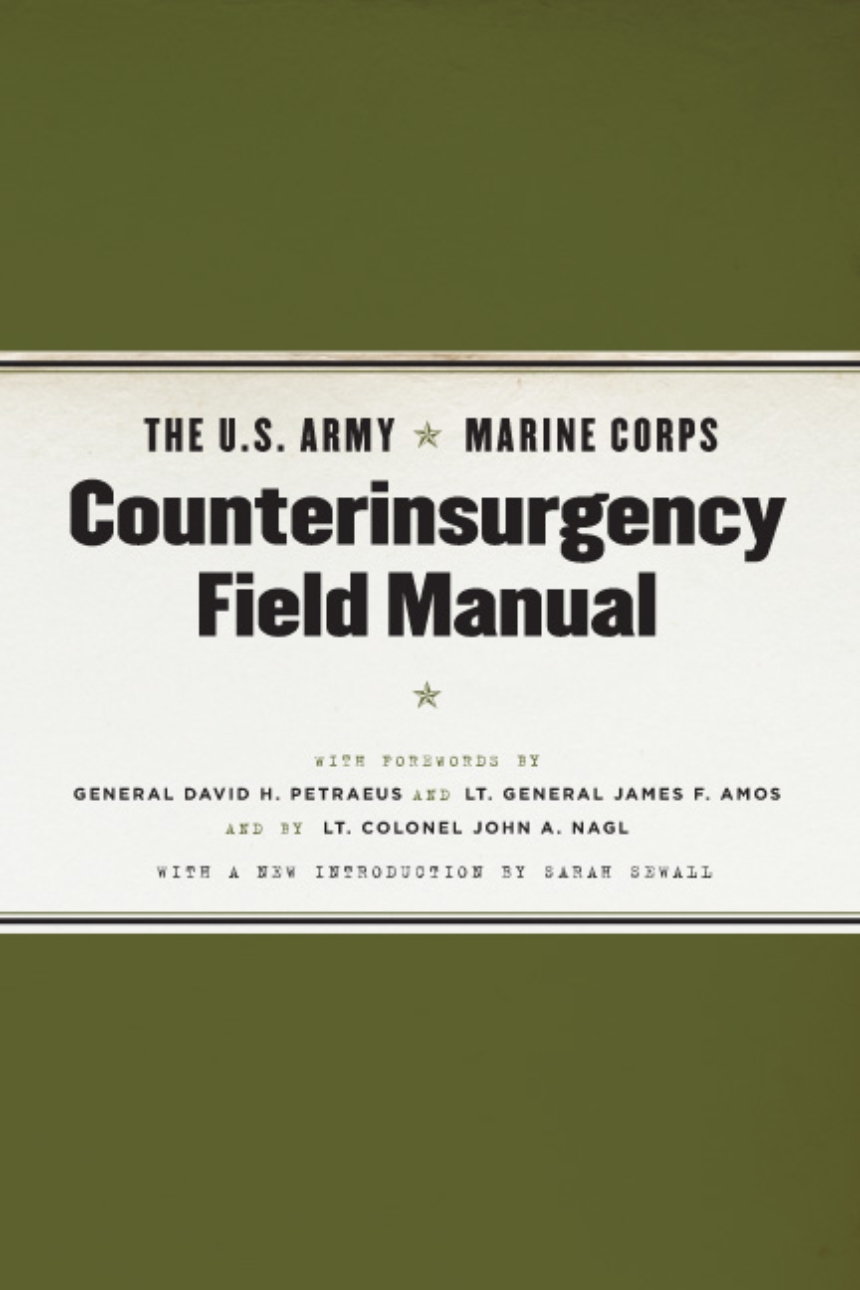The U.S. Army/Marine Corps Counterinsurgency Field Manual
The handbook the US military created to fight counterinsurgencies in the twenty-first century.
When the U.S. military invaded Iraq, it lacked a common understanding of the problems inherent in counterinsurgency campaigns. It had neither studied them, nor developed doctrine and tactics to deal with them. It is fair to say that in 2003, most Army officers knew more about the U.S. Civil War than they did about counterinsurgency.
The U.S. Army / Marine Corps Counterinsurgency Field Manual was written to fill that void. The result of unprecedented collaboration among top U.S. military experts, scholars, and practitioners in the field, the manual espouses an approach to combat that emphasizes constant adaptation and learning, the importance of decentralized decision-making, the need to understand local politics and customs, and the key role of intelligence in winning the support of the population. The manual also emphasizes the paradoxical and often counterintuitive nature of counterinsurgency operations: sometimes the more you protect your forces, the less secure you are; sometimes the more force you use, the less effective it is; sometimes doing nothing is the best reaction.
An new introduction by Sarah Sewall, director of the Carr Center for Human Rights Policy at Harvard’s Kennedy School of Government, places the manual in critical and historical perspective, explaining the significance and potential impact of this revolutionary challenge to conventional U.S. military doctrine.
An attempt by our military to redefine itself in the aftermath of 9/11 and the new world of international terrorism, The U.S. Army / Marine Corps Counterinsurgency Field Manual will play a vital role in American military campaigns for years to come.
The University of Chicago Press will donate a portion of the proceeds from this book to the Fisher House Foundation, a private-public partnership that supports the families of America’s injured servicemen. To learn more about the Fisher House Foundation, visit www.fisherhouse.org.
When the U.S. military invaded Iraq, it lacked a common understanding of the problems inherent in counterinsurgency campaigns. It had neither studied them, nor developed doctrine and tactics to deal with them. It is fair to say that in 2003, most Army officers knew more about the U.S. Civil War than they did about counterinsurgency.
The U.S. Army / Marine Corps Counterinsurgency Field Manual was written to fill that void. The result of unprecedented collaboration among top U.S. military experts, scholars, and practitioners in the field, the manual espouses an approach to combat that emphasizes constant adaptation and learning, the importance of decentralized decision-making, the need to understand local politics and customs, and the key role of intelligence in winning the support of the population. The manual also emphasizes the paradoxical and often counterintuitive nature of counterinsurgency operations: sometimes the more you protect your forces, the less secure you are; sometimes the more force you use, the less effective it is; sometimes doing nothing is the best reaction.
An new introduction by Sarah Sewall, director of the Carr Center for Human Rights Policy at Harvard’s Kennedy School of Government, places the manual in critical and historical perspective, explaining the significance and potential impact of this revolutionary challenge to conventional U.S. military doctrine.
An attempt by our military to redefine itself in the aftermath of 9/11 and the new world of international terrorism, The U.S. Army / Marine Corps Counterinsurgency Field Manual will play a vital role in American military campaigns for years to come.
The University of Chicago Press will donate a portion of the proceeds from this book to the Fisher House Foundation, a private-public partnership that supports the families of America’s injured servicemen. To learn more about the Fisher House Foundation, visit www.fisherhouse.org.
Read the foreword by John A. Nagl and Paradoxes of Counterinsurgency Operations from the first chapter.
472 pages | 30 figures, 33 tables | 6 x 9 | © 2007
Reviews
Table of Contents
Foreword to the University of Chicago Press Edition
Foreword
Foreword
PREFACE
INTRODUCTION
Chapter 1 INSURGENCY AND COUNTERINSURGENCY
Chapter 2 UNITY OF EFFORT: INTEGRATING CIVILIAN AND MILITARY ACTIVITIES
Chapter 3 INTELLIGENCE IN COUNTERINSURGENCY
Chapter 4 DESIGNING COUNTERINSURGENCY CAMPAIGNS AND OPERATIONS
Chapter 5 EXECUTING COUNTERINSURGENCY OPERATIONS
Chapter 6 DEVELOPING HOST-NATION SECURITY FORCES
Chapter 7 LEADERSHIP AND ETHICS FOR COUNTERINSURGENCY
Chapter 8 SUSTAINMENT
Appendix A A GUIDE FOR ACTION
Appendix B SOCIAL NETWORK ANALYSIS AND OTHER ANALYTICAL TOOLS
Appendix C LINGUIST SUPPORT
Appendix D LEGAL CONSIDERATIONS
Appendix E AIRPOWER IN COUNTERINSURGENCY
SOURCE NOTES
GLOSSARY
ANNOTATED BIBLIOGRAPHY
MILITARY REFERENCES
INDEX
INTRODUCTION
Chapter 1 INSURGENCY AND COUNTERINSURGENCY
Chapter 2 UNITY OF EFFORT: INTEGRATING CIVILIAN AND MILITARY ACTIVITIES
Chapter 3 INTELLIGENCE IN COUNTERINSURGENCY
Chapter 4 DESIGNING COUNTERINSURGENCY CAMPAIGNS AND OPERATIONS
Chapter 5 EXECUTING COUNTERINSURGENCY OPERATIONS
Chapter 6 DEVELOPING HOST-NATION SECURITY FORCES
Chapter 7 LEADERSHIP AND ETHICS FOR COUNTERINSURGENCY
Chapter 8 SUSTAINMENT
Appendix A A GUIDE FOR ACTION
Appendix B SOCIAL NETWORK ANALYSIS AND OTHER ANALYTICAL TOOLS
Appendix C LINGUIST SUPPORT
Appendix D LEGAL CONSIDERATIONS
Appendix E AIRPOWER IN COUNTERINSURGENCY
SOURCE NOTES
GLOSSARY
ANNOTATED BIBLIOGRAPHY
MILITARY REFERENCES
INDEX
FIGURES
TABLES
VIGNETTES
TABLES
VIGNETTES
